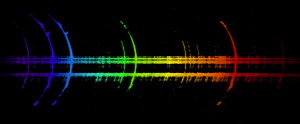The last Bailey's bead is just fading. The solar limb which was several
seconds ago brightly shining has changed its color to deep red.
Now the approximately 2 seconds long period begins, the period which
played very important role in the history of the solar mystery discovery.
The famous astronomer Charles August Young (1834 - 1908) observed the total solar eclipse
with spectroscope on December 22, 1870. He started the observation
shortly before the total eclipse beginning. The solar spectrum, well known
to him, was continually decreasing its intensity. In the very moment when
the last Bailey's beads had disappeared he observed peculiar phenomenon.
The solar spectrum got inverted, i.e. dark so-called Frauenhofer lines
changed to bright ones on dark background. The inversion of spectral lines was
visible for about two seconds and after that bright lines disappeared. These two seconds
enabled him to grasp very much. The white light of solar photosphere with
continuous spectrum is coming through the gas layer which absorbs the light
on some wavelengths. Consequently, the gas emits the light on these wavelengths
into all spatial directions. If we observe the photosphere light coming through
this gas layer we can see absorption (dark line) spectrum. If the Moon covers the solar
photosphere in the beginning of the total solar eclipse we can see the gas layer
above the photosphere on the the dark space background for approximately two seconds.
The light of this layer has the emission (bright-line) spectrum. The name of this
thin layer above the solar photosphere is
chromosphere.
No slit is necessary to be used in spectroscope for observing the solar spectrum
several seconds before the total solar eclipse. The narrow crescent of shining
Sun not covered by the Moon plays its role. Therefore spectral lines in this
so-called flash spectrum have the crescent shape. If you study the flash spectrum
reproduced on this page you can see not only the bright lines on black background
but also narrow bands of continuous spectrum with dark absorption lines. These bands
belong to the last Bailey's beads, i.e. to the solar photosphere.


